You are currently browsing the multiverse talk category
So I forget where I saw it referenced, but somewhere out there someone had mentioned the 1996 Silver Surfer/Superman one-shot, which got me to wondering if I still had it. I had bought nearly all of the Marvel/DC crossover comics that were cranked out during that period of the 1990s when both companies were desperate to attract sales by doing pretty much anything, and that included joining forces to publish things like this.
Anyway, when I opened the shop, I pulled a boatload of comics out of my own collection to populate the back issue bins, and that included a lot of the attention-grabbing intercompany crossovers between DC and Marvel, once ubiquitous but now getting more and more difficult to find in the wild. I did give up my Superman/Fantastic Four treasury edition, foolishly, and I’ll need to replace that, but I did keep my other Superman-related Marvel crossovers, including that Silver Surfer/Superman comic by George Perez and Ron Lim:
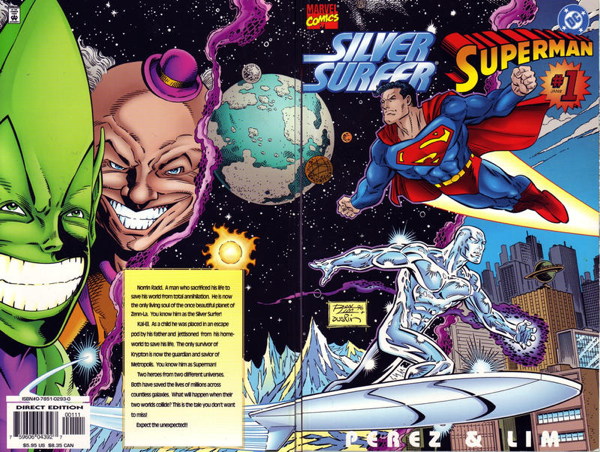
Like how the “Death of Superman” story is Of Its Time, featuring the now-headscratching-to-newcomers elements of Red-Haired-And-Bearded Australian Son of Lex Luthor along with Artifical Glob-Life-Form Thingie Supergirl, Silver Surfer/Superman involves, for at least part of the book, the Contessa. Yeah, I know, “Who?” I’d completely forgotten about her, though once she popped up in the story I was all “oh yeah, that lady.”
She basically usurped Luthor’s position as the head of his company Lexcorp after…well, read this if you need to know her deal, and how she was sorta unceremoniously removed from the book. Anyway, she’s here in this SS/S funnybook for about the first half, and this sequence of panels features what I’m pretty sure is a writing/editing mistake EDIT: I’m wrong, I misread it:
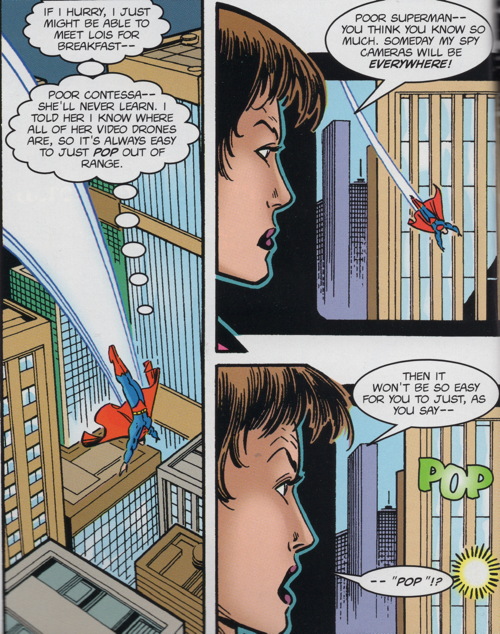
Superman thinks the phrase “just pop out of range,” and the Contessa, just a couple of panels later, starts to mockingly quote what he thought, only to be interrupted before she could say “pop” by an actual “POP!” by the teleported entrance of the Impossible Man. And how did the Contessa hear what Superman was thinking? Did she have mind-reading powers that I forgot about? EDIT 2: Somehow I missed the “I told her” part. Ah well.
But speaking of Impossible Man, having him and Mr. Mxyzptlk as the antagonists of this story was a nice touch. The temptation of having the two heroes face off against Luthor and, say, Mephisto in a more serious conflict was likely strong.
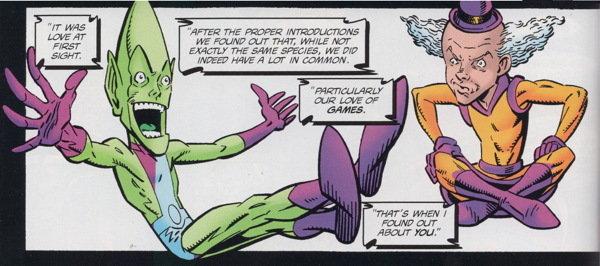
The plot involves Mxyzptlk and Impossible Man swapping “universes” and heroes, pitting Mxyzptlk against the Surfer and so on. Which of course brings to mind Superman #50 from 1990, where it is implied heavily that Mxyzptlk travels to the Marvel Universe and torments the Fantastic Four as the Impossible Man, establishing the two characters are one and the same.
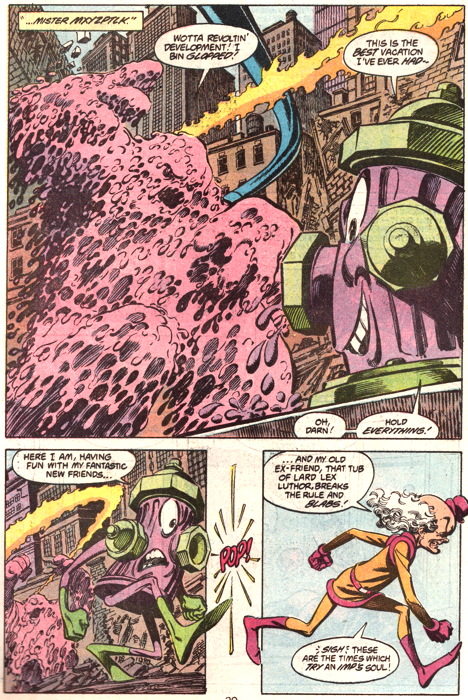
I don’t particularly like this early post-Crisis/early Byrne’s Superman run version of Mxyzptlk where he was a little nastier, a little more malevolent. I guess it was fine for one or two appearances, but I like Funny, Wacky Mxyzptlk, which he eventually evolved back into in the comics, more or less. Although I was okay with Goth Mxyzptlk from Alan Moore/Curt Swan/Kurt Schaffenberger in their “Whatever Happened to the Man of Tomorrow” final pre-Crisis Supes story:
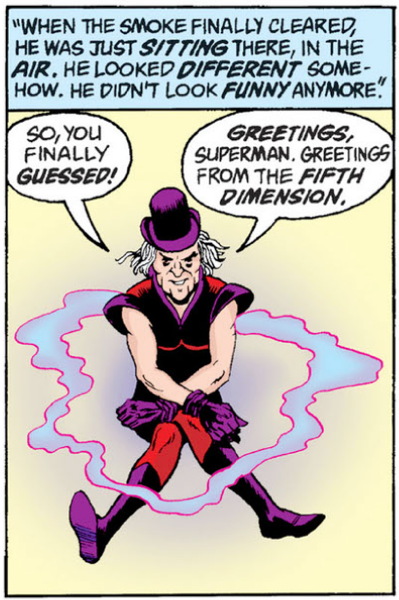
Mentioned in the story is the character Access, the Marvel/DC co-owned character whose ability was to cross characters over from either universe, and I’m presuming hasn’t been used much lately. And there’s also some track-covering with the idea that both Superman and Silver Surfer will forget this encounter, allowing it to kinda-sorta stay in regular continuity and explaining why, like, Superman won’t reference the event in a non-crossover-sanctions issue of Action or wherever.
I sort of miss those days where it seemed like every week we got a new crossover between different comic book publishers. They still happen today, of course, but not nearly as often. There’s a new Batman and Spawn book coming soon, for example. But back in the ’90s, I had that brief glimmer of hope we’d get that Swamp Thing/Man-Thing team-up the world deserved. Well, I deserved, I don’t know about you guys.
Going back to mid-August, David Conner relates
“Supergirl’s JL animated origin (actually from the Superman show IIRC) was substantially lifted from the underrated Superman vs. Aliens comic. Which was published during the period when DC didn’t have a Supergirl in continuity.”
Okay, it’s been a while since I’ve 1) read Superman/Aliens, and 2) watched the relevant episodes of Superman: The Animated Series. However, a peek at the Wikipediatron does show [SPOILERS AHEAD]:
1. Neither Supergirl (or rather “Kara” in the Aliens book) is actually supposed to be the Kara Zor-El, Superman’s cousin.
2. Both are survivors from a dead planet that is not Krypton, though there is some connection to Kryptonians in both their backgrounds.
As I’ve stated before multiple times before, DC put a whole lot of effort into, if not outright undoing Crisis on Infinite Earths, then at least referencing those elements of the DC Universe done away with by that series. I mean, not that either of these were part of the DC Universe…the animated series was, well, the animated series (though the white top/blue skirt costume would pop up briefly on the other Supergirl I’ll mention in a moment); and Superman/Aliens wasn’t technically an Elseworlds, as it didn’t directly contradict any then-established continuity (I think), but the use of the licensed Aliens property probably separates it out from the DC Universe mainstream.
[An aside: I mean, the story could still be referenced — “remember that time we fought a bunch of crazy extraterrestrial beings” with a flashback panel hiding the Aliens in shadow or something. I know there were some changes to the Wildstorm Universe superhero stuff in their Aliens crossovers. But to my knowledge the story was never referenced again, except possibly in Superman/Aliens II, the New Gods one, even though both kinda/sorta left open threads for follow-ups.]
Thom H. reminds us
“So much better than ‘protoplasmic blob from a pocket dimension that got fused with an angel(?).’ I know that Peter David series was popular, but I never did understand it.
“If writers at DC wanted Supergirl back, they should have just brought Supergirl back instead of jumping through so many weird hoops.”
Hmmm…I was trying to come up with a short explanation, but it was getting too long, so let’s just say that protoplasmic being was created by an alternate universe Lex Luthor where, in the form of Supergirl, attempted to protect that Earth from that dimension’s evil Kryptonian villains. She was eventually brought to Main DC Universe Earth where she (mostly) remained in the form of Supergirl until…well, you know what, this detail from the box of a Supergirl statue sums it up:
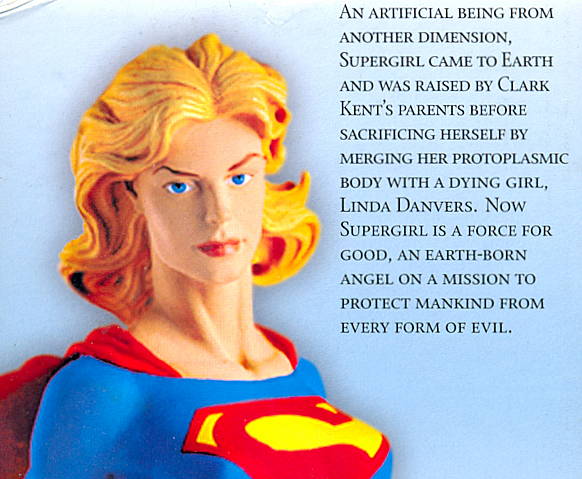
And while I did like Peter David’s Supergirl run (which did last 80 issues, which is almost like an eternity in modern comic book terms, so folks did seem to enjoy it) it wasn’t the easiest premise to explain. Even the ultimate ending of this version of Supergirl wasn’t entirely cut ‘n’ dried. There was some very heavy implying in the Fallen Angel series David later did for DC that the title character was in fact the lead from his Supergirl series. And when the series moved to another company, the eventual reveal was that it was not Supergirl/Linda Danvers, but in a hopefully non-copyright-infringing way, Supergirl/Linda was involved in Fallen Angel‘s backstory. (And then Linda Danvers makes a brief appearance in DC’s Reign in Hell series, so she was still in the DC Universe in one way or ‘nother.)
Of course, with all the New 52/Rebirth/Whatever Else shenanigans the DC Universe has gone through, it’s probably likely that the events that lead to the introduction of Pocket Universe Protoplasmic Supergirl did not happen in current continuity as shown. I mean, I think we’re still dealing with the post-Crisis/pre-New 52 Superman who somehow crossed over into modern continuity, so maybe that all happened to him, but not to DC’s continuity at large. If you’re not following any of this, don’t worry, I’m barely following it myself.
It’s all kind of moot anyway, as DC stopped screwin’ around and finally said “OKAY FINE, HERE’S SUPERGIRL, SHE’S FROM KRYPTON, SHE’S SUPERMAN’S COUSIN AGAIN” and reintroduced her in 2004’s Superman/Batman #8. This comic is…well, not good, but it finally got a new version of the Classic Supergirl back into comics, and later creators did some fun things with her (especially around — 2019, I think? — when some Omega Men and other pals and gals showed up). And that’s the Supergirl we have floatin’ around today, assuming I haven’t missed a revamp or reboot somewhere along the line.
So this panel has been, as they say, living rent-free in my head ever since I first read it in All-Star Squadron #3 way back in 1981:
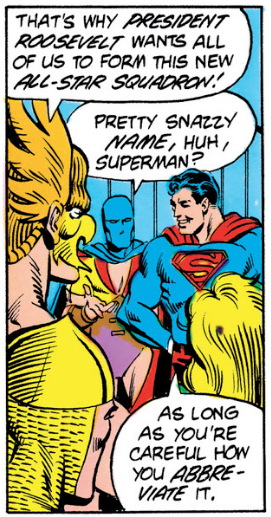
As a 12-year-old, I thought that was pretty much the height of wit, and even now as a slightly-more-than-12-year-old it amuses me a bit. Yes, “All-Star Squadron” is a good, catchy title, but how do you shorten it without showing your whole…well, you know?
Now here’s the thing: while I read the first dozen or so issues of the series at the time (and then dipped back in on occasion on and off ’til its eventual cancellation), I can’t for the life of me recall just how they got around it in the editorial/letters pages? This just wasn’t a joke for a comic book, it was probably a small concern behind the scenes as well, as titles were regularly shortened for convenience (like JLA, DET, ADV, LSH, A&A, B&HB, ADVDMJL, etc.).
This will be a question I might be able to answer for myself once I get back to the shop and poke through the stock, but does anyone recall what they did? My suspicion is that they eschews abbreviations entirely, or just called it ALL-STAR or something. I feel like ASQ would be the ideal solution, but I don’t know what they did, or at least I won’t for a few hours.
Anyway, it’s funny that it’s Superman that gets to the off-color gag first. Though, it’s fine because this is the Earth-2 Superman and he always seemed to be a little more rough ‘n’ tumble given his Golden Age origins. Also, that panel gives you a bonus look at Hawkman’s weirdo fullface mask. Like, what is up with that tongue, dude?
There you go, a silly sorta-throwaway joke from Roy Thomas, Rich Buckler and Jerry Ordway. And only “sorta” because I’m sure what Superman was saying was exactly what Rascally Roy and the DC editors were thinking.
Yup, I’m still addressing comments left on this site from nearly two months ago. What can I tell you?
So Daniel sez
“Byrne’s first meeting of Superman and Luthor in Mos #4 was soooo much more interesting than the pre-Crisis Superboy-causes-Lex-to-lose-his-hair-in-a-lab-accident”
Now let me just step in here for just a sec and defend the “Superman makes Lex lose his hair” thing. I’m not going to say you’re wrong for your position, for reasons I’ll get into, but I think Superboy being at least partially responsible is good actually, and fits tonally with the kind of stories being told in Super-comics of the time.
We’ve all probably seen this sequence, or something like it, from Adventure Comics #271 (1960) by Jerry Siegel and Al Plastino. Lex, the local boy genius who had been fast friends with Superboy, was working in his lab (built by Superboy, in fact) to create a cure for Kryptonite for his super-pal. Suddenly Science Goes Awry and the Boy of Steel blows out the flames and smoke in the exploded lab, only to discover:
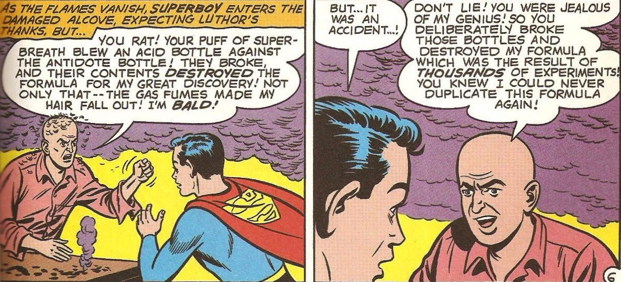
This works in the Superman books of the day in that is fits the general low rent level of almost dreamlike myth-making in the stories. Motivations and broad and simplistic, intended to be easy for children to understand. (I’m put in the mind of an early ’60s Green Lantern story where the impetus for Sinestro’s actions was that he losing out in some popularity contest with another villain and he wanted to regain the top position.)
“You did something bad to me” (well, sort of) “and now I hate you forever!” is a plain enough explanation. Plus, it was probably a surprising twist for readers to discover that adult Luthor’s baldness was tied to the actions of a young Superman. It’s all very “closed-circle” kind of stuff. And this doesn’t get into the mythological/Samson-esque implications of a loss of hair equating a loss of strength and virility.
In other words, It Was Good Enough, at least for the time. As the actual stories of Lex vs. Supes played out, it was not so much about “my beautiful curls!” but just Luthor trying to find ways to commit crimes and outwit and/or destroy Superman. So the hair thing didn’t really play that much into the enmity between the two, aside from the occasional flashback. Now, had Luthor spent all his time trying to cause Superman to lose his hair, well, that’d be another story entirely. I think there were one or two stories like that, but it wasn’t, like, Lex’s thing.
When the Superman comics entered the ’80s, it was decided to change things up just a little bit. Not Crisis on Infinite Earths-levels of changing up, that would be a couple years hence, but for Superman’s 45th anniversary in 1983, here in Action Comics #544 by Cary Bates, Curt Swan and Murphy Anderson, Luthor was given all-new reasons to hate the Man of Steel.
Long story short, Lex was living on the planet Lexor, where everyone loved him, and he and Superman were fighting, Lex fired an energy beam at him with his fancy new armor, the beam bounced off Superman and hit a big doodad that was keeping Lexor’s core stable, and everything went kablooie. Lex of course blames Superman entirely, resulting in:
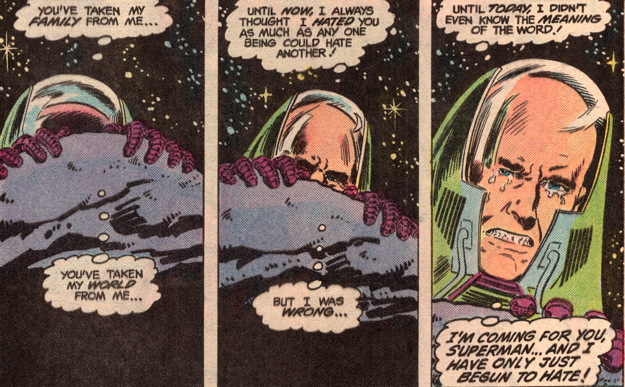
A more brutal origin for an age when comics were, just very slightly, beginning to get a little edgier with their storytelling…not that Superman was going to suddenly become, I don’t know, Frank Miller’s Daredevil or anything. But we were getting to the point where the more fantasy-ish “loss of hair” origin wasn’t enough in comics, where a little more grounding in reality (relatively speaking) was becoming more in vogue.
As it turned out, this New Unleashed More Dangerous Than Ever Luthor only popped up a handful of times before the aforementioned Crisis came along, and frankly things weren’t much different than before except for Luthor having his new space armor suit.
With Crisis and the accompanying sweeping 1986 reboot of the Superman line by John Byrne, all that previous Luthor stuff was cast aside, and a new relationship between the two was forged. “Introduced” in Man of Steel #4, our new Luthor is now a wealthy businessman whose successfully hides his shady side from the public (causing a lot of comparisons to Marvel’s Kingpin in the process):
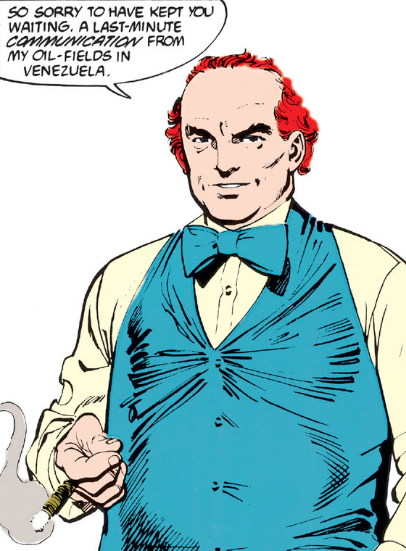
And yes, he has hair. At least until Lois slings this parting shot at him after an eventful evening:
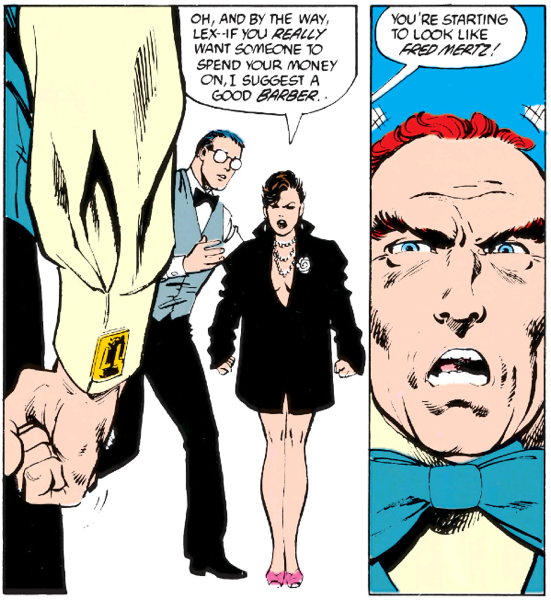
…which, hey, I don’t know, don’t be hairline-shaming my man William Frawley:
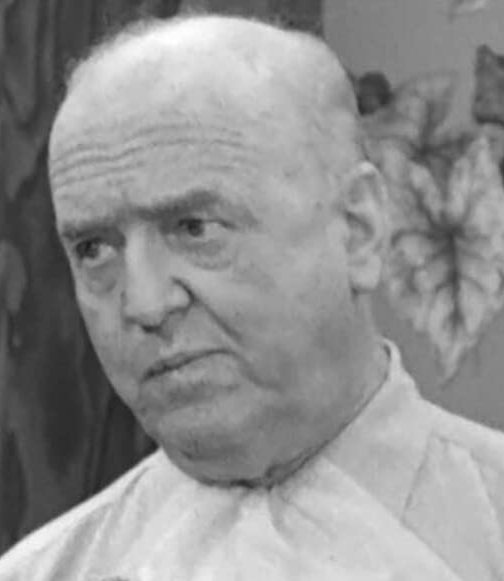
But this being the motivation for Lex to start shaving his head clean (as he appears sans hair in EDIT: his very next appearance Superman #1 – was reminded in the comments he didn’t go Full Yul ’til after the Man of Steel mini was over) is frankly just as silly as Superboy blowing Kid Lex’s hair away after a lab fire. BUT TO BE CLEAR I know this isn’t the argument at hand. Hair is removed as a motivation for Luthor’s behavior…now it’s just a small point being made about his vanity.
Luthor’s hatred of Superman comes from the Man of Tomorrow’s replacing Lex as the most powerful man in Metropolis. This is a more modern, a more…well, using the word “subtle” for anything Byrne works on is bit of a misnomer, but it is a more nuanced take on his hatred for Supes than “I lost my hair.” It rises out of the character’s personality, a change that comes from the increasing demand for the approximation of “realism” and storytelling sophistication in comics.
In a way, though, it still hearkens back to the childlike simplicity of comic character motivations of decades past: “I was the biggest guy, now someone else is bigger, and I hate him.” It probably just comes down to being more relatable…everyone’s been jealous of someone else, but very few people have experienced a friend causing their immediate and total hair loss. Unless, you know, their arch-nemesis is an evil barber or something.
As a small addendum, one of the elements of the Smallville TV show I appreciated is the fact that the meteor swarm that stuck the town, the one in which baby Kal-El’s rocket was enmeshed, was responsible for a young Lex’s baldness. Bringing back the “Superboy was kinda responsible for that” which had been missing from the other live-action adaptations…nicely played.
David Conner brings up
“I could see this [multiversal] stuff really confusing ’80s Hollywood people. OTOH, I think then as now, if Hollywood wanted to make a movie with both Doctor Fate and Shazam! characters, they’d just do it and ignore the ‘different Earth’ stuff.”
That is a point I never considered. I mean, you’re right, if they’re really on a tear about doing, I don’t know, a Johnny Thunder movie, they’re gonna do one regardless of how convoluted the character’s milieu may seem.
But I can see that parallel Earths business being an additional barrier to, well, in this case Hollywood folks, but in general to everyone else too. While it’s not too complicated a concept (often being explained in a single panel, or even a single caption box, when necessary), it’s possible someone looking for a property to exploit (or alternatively a reader just looking for something to read) might see this weird explanation about this character is from some Earth or ‘nother and think “nope, I’ll move onto something else less complicated.”
Now you know, and I know, and even pal Ian knows, the whole parallel Earth thing isn’t complicated. If I got it when I was, what, nine or ten years old, it couldn’t be that hard. But it could give off the appearance of complication, and even the smallest hurdle is enough to stop somebody. Even with “THE MULTIVERSE,” at least vis-à-vis comical books, being a thing in most everyone’s awareness and understanding now, not just with the funnybook-initiated, there’s still someone watching these Marvel movies and despairing aloud “what? Three Spider-Men? What’s going on? How did that happen? I don’t get it!”
• • •
Michael Grabowski
slaloms in with
“I feel like this is a problem only comic book nerds have, as in the general public doesn’t particularly care. There are all the different movie & TV conceptions of Superman/Superboy and Batman of the last 50 years, and the people who watch those don’t seem to let continuity conflicts (or casting changes) get in the way of enjoying what they’re watching.”
Just imagine how many headaches could’ve been avoided if DC had started a new Hawkman series, and everyone had been all “how does this tie in with Hawkworld and Crisis and the Golden Age Hawkman and and” and DC’s response was “shut up, here’s a Hawkman comic, he fights gentlemanly ghosts and shadow crooks with a mace, DON’T MAKE IT MORE COMPLICATED.” But there’s always some measure of continuity shenanigans getting in the way (though the most recent Hawkman series leaned into it with good effect), not just with Hawkman but with DC’s incessant need to continually relitigate the original Crisis on Infinite Earths and explain the multiverse again. As the boy on a recent episode of War Rocket Ajax noted, it seems like DC’s multiverse has come back several times over the last few events.
It seems like the only way to break this cycle in comics is to…ignore it. Just tell the stories without wondering what Earth it’s taking place on. I know, I know, most do that anyway, but every time, DC has to go and remind everyone “oh hey remember parallel Earths? Let us explain them to you” However, the parallel universe thing is mostly restricted to these events, so it doesn’t interfere with the flow of the regular monthly books too much. Except when they tie in, of course.
The movies worked by simply not acknowledging the other films. “Here are four ‘Burtonverse’ Batman films” and “here are three Christopher Nolan Batman films” and never the twain shall meet, one does not refer to the other, and also the movies are several years apart so the idea of “hmmm, I thought Joker died, but here he is again, a lot skinnier and younger than last time” probably shouldn’t come up. (But, y’know, there’s always the one guy….)
Of course now the new superhero movies do all refer to each other, and like I referenced with those three Spider-Men earlier, now reference movies outside the world of the films. And we’ve got the multiverse thrown in for good measure. So far Marvel’s managed to keep everything more or less straight, with a minimum of confusion, and using the continual crossovers to drive audiences to the next installment, whatever it may be. Even after a decade or so, it hasn’t turned into a problem…yet.
Cassandra presents
“Mike, the main reason Wonder Woman survived into the 50s has to do with the terms of the original contract between AA/National and Marston. If there came a period where she didn’t appear in a comic published for a certain length of time (I’ve heard two months), the rights would revert to the Marston estate. So, Wonder Woman might be the first comic that continued to be published solely for a rights issue!”
If I recall correctly, it was Kurt Busiek who first unleashed this knowledge onto the world…some kind of deal where he mentioned “oh yeah that post-Crisis, pre-Perez series mini I wrote was done else DC lose the Wonder Woman rights” and the rest of the funnybook resident was all “…wait, run that by me again?”
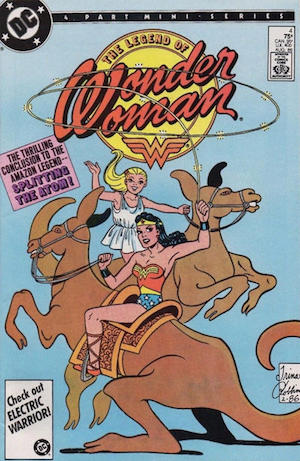 Now that’s entirely paraphrasing, but it was something along those lines. The Legend of Wonder Woman, scripted by Busiek and illustrated by Trina Robbins, was released in the year-long interim between the cancellation of the original Wonder Woman series and the George Perez/Greg Potter relaunch. Apparently, without that mini being rushed into production and released, that publishing gap would indeed have been enough to trigger whatever contractual clause existed to revert all Wonder Woman rights to the Marston estate. Last month’s issue of Back Issue, the ’80s DC Mini-Series issue, features a good interview with Busiek and Robbins about the series.
Now that’s entirely paraphrasing, but it was something along those lines. The Legend of Wonder Woman, scripted by Busiek and illustrated by Trina Robbins, was released in the year-long interim between the cancellation of the original Wonder Woman series and the George Perez/Greg Potter relaunch. Apparently, without that mini being rushed into production and released, that publishing gap would indeed have been enough to trigger whatever contractual clause existed to revert all Wonder Woman rights to the Marston estate. Last month’s issue of Back Issue, the ’80s DC Mini-Series issue, features a good interview with Busiek and Robbins about the series.
One of the details I believe I learned from that interview was that it had to be specifically a title starring Wonder Woman. Guest-appearances in other comics, or even just being a member of the Justice League, wasn’t enough to keep the shepherd’s crook at bay and yanking her offstage.
Now I’d assumed after that close call, as the series was rushed into production after someone realized that contractual issue, that DC/Warners went to the Marston estate, pulled out the checkbook, sighed and asked “…okay, how much?” I presume that was the situation when DC nailed down the Shazam!/Captain Marvel rights a couple/three decades back instead of just continuing to license the characters from Fawcett. Anyway, in that Back Issue interview Busiek said he wasn’t sure what the situation was regarding the Wonder Woman contract, and whether that clause was still in effect. If there’s been clarification on this since then, I’d like to know.
As I noted in the post upon which Cassandra was commenting, in that otherwise superhero-less gap between the Golden and Silver Ages, Batman, Superman and Wonder Woman continued to be published because they were still money-makers. In Wonder Woman’s case, yes, that title was still making money via all the toys and such DC was able to license, which certainly gave them incentive to keep the title going. Not just to encourage more licensing, but to keep their mitts on the property so they could continue making that toy-and-costume scratch.
Now as to whether or not any other titles continued on solely to retain the rights…well, technically, that’s the deal with pretty much any licensed property, but I know what you mean, Cassandra! There was that aforementioned licensing arrangement DC had with Fawcett over usage of the Shazam! family of characters, but I don’t believe that would’ve been a “use it or lose it” kind of deal. I don’t think there were too many long gaps with DC’s usage of Captain Marvel anyway, so I don’t believe that to be entirely analogous. But I can’t think of anything else that’s quite the same. Something to look into, perhaps!
Also, I should note that I’m filing this under the “Multiverse Talk” category not just to continue the conintuity of converssation, but also because the Legend of Wonder Woman mini includes a nicely appropriate send-off to the Earth-2 Wonder Woman!
Wayne sallies forth with this comment regarding the Justice Society’s continuing vitality into what should have been their 90s:
“Better than explanations like exposure to Dr. Fate’s magic kept them young. That excuse, or something close, was in some story or arc I can’t really remember. Possibly […] JLA: Year One. Hourman and Alan Scott are in a cage with Silver Age characters on the cover of the trade.”
I have to be honest, I don’t recall many wide-reaching explanations for the JSA still kickin’ around as long as they did pre-Crisis. Let’s say the youngest of them was, oh, 20 in 1941. By the time we hit the whole Flashpoint/New 52 thing in 2011, that theoretical 20-year-old JSAer (let’s face it, that would be Johnny Thunder) would be around 90. And again, going with my assumption in a previous post that the JSA essentially worked in “real time” (vs. modern superheroes, with their sliding 5/10/20 year-scales, depending on who you ask/where you jump in during rebootery), with heroes first becoming active in the late 1930s/early 1940s, at mostly college age or older, they’d all be well into their 90s or even pushing 100.
There were general excuses for characters still hangin’ on there, like maybe Jay “The Flash with the Hat” Garrick’s connection to the Speed Force, and didn’t Alan “Green Lantern” Scott get de-aged by the mystical energy of his lantern or somesuch (into “Starheart,” I believe). [EDIT: Sentinel, actually.] I mean, you could just say “their super powers kept them, and some of those around them, young” and not go into much more detail than that.
Another possible way their ages could’ve been their brief exodus from the DC Universe in Last Days of the Justice Society:
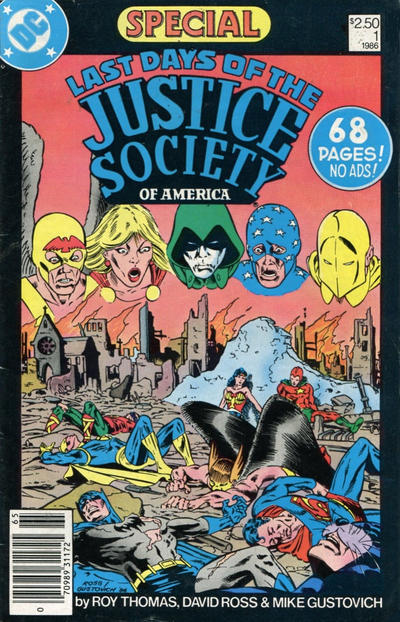
…in which they are pulled into another dimension and forced to fight an eternal battle until some years later when they were recovered in some event or ‘nother. This could have been the Steve Rogers/Captain America solution, where a WWII character is taken off the table and “preserved” for an indefinite amount of time, with his revival pushed farther and farther into the future as publishing of the character continues. When Captain America was first revived in the 1960s, he’d only been “gone” for 20 years. Now that we’re in the 2020s, that time he was frozen in the ice is now, what, 60 years? It’s attaching that modern hero “sliding scale” to Golden Age characters. (And my apologies…this sounds vaguely familiar, like this idea was brought up in my comments recently…I’m not plagiarizing you on purpose, honest.)
And also there’s just straight up immortality or extended lifespans because you’re a super-powered being from another planet (Superman) or an Amazon (y’know, Wonder Woman). I mean, yeah, sure, they aged, but c’mon.
Plus there’s also the possibility of simply unhooking them from the WWII era and making them just, I don’t know, older heroes who’d been around prior to the new generation. This is kind of he tack they’re taking on the Stargirl TV show, but it feels weird to not have them associated with that specific conflict. And moving them to another war would be…well, just postponing the problem, really, and honestly would you went them to be Vietnam War vets? Gulf War vets? That would be really strange, and as-is would be hard to retrofit the JSA into one of these more modern settings and have them retain the same sort of feel.
The one overall explanation I do recall is from the third All-Star Squadron annual from 1984 by Roy and Dann Thomas and a whole pile of artists. It’s a clever story, and set in the early 1940s, but I’m going to focus on the climax. Here, in the segment drawn by Rick Hoberg, the JSA is fighting the villain of the piece, Ian Karkull (you just can’t trust people named Ian), who’s been killing folks and absorbing “time energy” and that sort of nonsense:
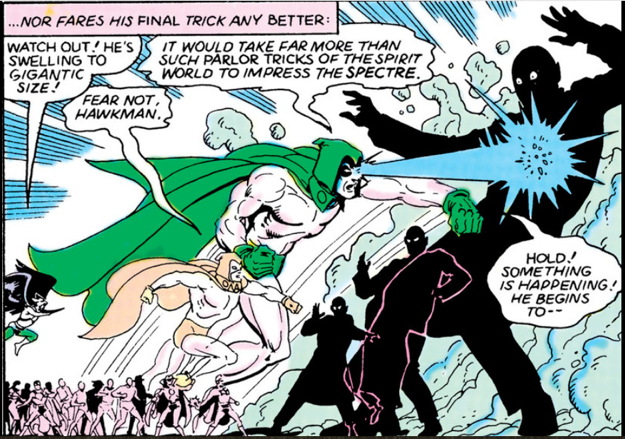
And like any decent bad guy at the end of the story, he explodes:
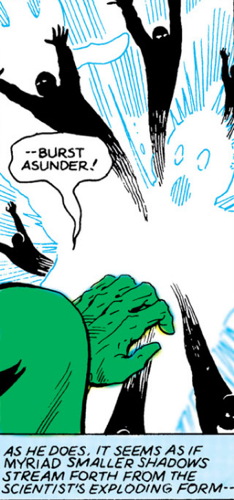
…and the JSA and some associated cast members get bathed in the resultant rain of energy:
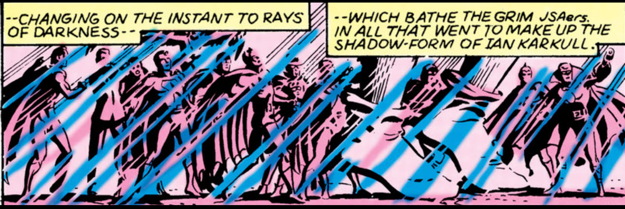
It makes our heroes feel weird, though it should be noted the greenish tint was not an in-story indicator that something peculiar has happened, but rather was an unusual printing issue in the original printed comic that left skin tones miscolored on several pages. I was hoping they’d fix this for the digital presentation I’m snagging these panels from, but alas:
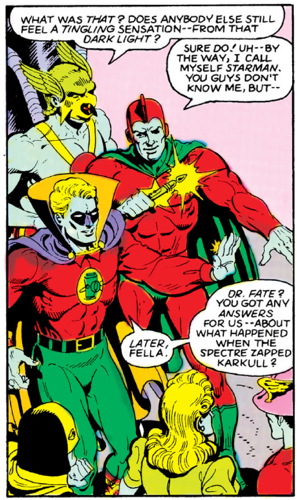
Also, way to just dismiss Starman, GL, I mean seriously.
But here come Big Time Movie Star Dr. Fate and his ghostly pal the Spectre with some mystical explanations:
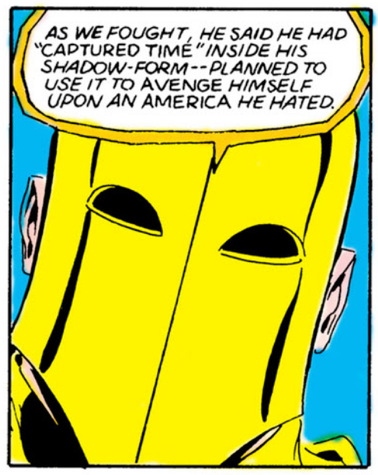
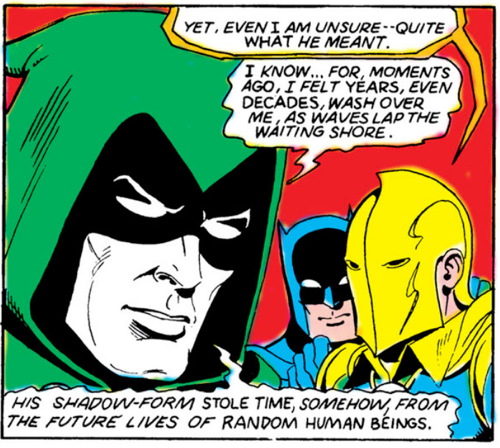
Lois Lane wonders how this energy would affect them, and Jay’s wife Joan just lays into her for no real good reason:

And then, the clincher: here’s why the JSA is still around in the 1980s, kids, well into their 60s!

Also, is this “Get on Starman’s Case” day here or what? Though in the conclusion of the annual, Hourman is like “yeah, I gotta take some time off” and Starman is all “I’LL TAKE HIS PLACE ON THE TEAM, C’MON GUYS” so maybe he had it coming. Plus, the Atom specifically saying that is pretty funny.
Anyhoo, that’s the explanation I grew up with reading the adventures of the Earth-2 then later Regular DC Earth Justice Society. If there were other reasons given (for the whole team, just a member here or there) please remind me. I’m sure I’ve read one or two others, but this was The Big One as far as that topic was concerned.
There’s a lot of Comics Ages talk in the comments to this post — well, a lot of talk in general, hi Sean! — especially about the term “Bronze Age.”
Now that’s something I’ve poked at a few times in the past on this blog, like way back in 2008 and then relatively recently in 2019, and I’m sure one or two more times but you get the point. I’m not a huge fan of the term “Bronze Age,” and as I point out in one of those old entries, even the Overstreet Price Guide was all “yeah, that’s not an official Age of Comics” until suddenly it was an official age of comics.
Also as I’ve said, those are all just marketing terms to help sell old comics, whether it’s a publisher trying to make their reprints of 1940s books sound like a Big Deal instead of just filling some space in a World’s Finest 100-pager, or it’s someone trying to make their old issues of Arak Son of Thunder seem fancier by slapping a “COPPER AGE CLASSIC!” sign on their box.
Bronze Age eventually made the Comic Ages cut after enough people started using it to describe their books…and after getting enough distance from the period to be able to say “yes, this period of comics does look distinct enough from what came before and what came after to make it its own thing.” But that said…I feel like 1984 is too late a cutoff date for the period. Crisis on Infinite Earths I think is what’s being used as the break between ages, given its massive (and continuing) impact on DC Comics and how other publishers handled big events with their title. I’d say New Teen Titans #1 in 1980 would make a better separation point, given its new style and direction for the team and how it energized DC to an extent, and it’s what lead Marv Wolfman and George Perez to Crisis. I’d say it’s as much as a demarcation point as Showcase #4 in terms of “this is what superhero comics are now.”
(Yes, New Teen Titans is walking in X-Men‘s footsteps, but that would really disrupt the whole “what is Silver/Bronze/Copper” thing and I’m too tired to deal with that right this second.)
Daniel T notes that he’s not a fan of “Bronze Age” including stuff like Love and Rockets and Nexus, and that’s fair enough, as Comic Ages tend to be DC/Marvel/superhero-centric anyway. I mean, I don’t know that I’ve ever seen the underground comic God Nose described as a “Silver Age book.” There’s a case to be made that undergrounds/small press/indies are their own thing, outside the main “comic ages” universe. A parallel universe of comics history, if you will. One that contains the “Black and White Boom/Bust,” a phenomenon almost entire separete from the color superhero funnybooks.
I mean, people will use those terms for “Cerebus #1 Bronze Age Key!!!” or “Bone #1 Copper Age Key!!!” but…I don’t know. I don’t have an answer. And the rise of indie titles was a big part of the comics industry…pushing the Bronze Age back to 1980 to include a lot more of them would be nice.
Anyway, not going to solve this issue right here and right now, and yes we still need to come up with divisions to split up that “Modern Comics” age. I came up with a good’un in one of my old posts linked above.
So Hal Shipman sailed in with
“IIRC, ‘X’ was an allusion to what they really wanted to call that Earth: Earth-Swastika, i.e. where the Nazis won.
“Kind of like (but not really) where he Fawcett world was Earth-5, rather than Earth-S because a) they were already were using numbers, mostly, and b) someone thought everyone would think the ‘S’ was a ‘5’ anyway.”
To which the I’m sure entirely-coincidentally-named S responded
“Wait, I’m confused – wasn’t the Fawcett world Earth-S?”
The answer is, yes at first, when DC Comics started publishing the Marvel Family, they were relegated to another parallel Earth, eventually dubbed “Earth-S.” The “S” of course stands for the same thing as the S on Jughead’s top:
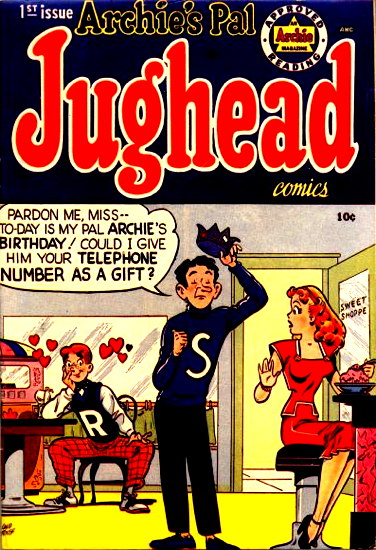
Anyway, it was cited as such whenever multiversal shenanigans cropped up involving the Big Red Cheese, such as this example from DC Comics Presents #33 (1981):
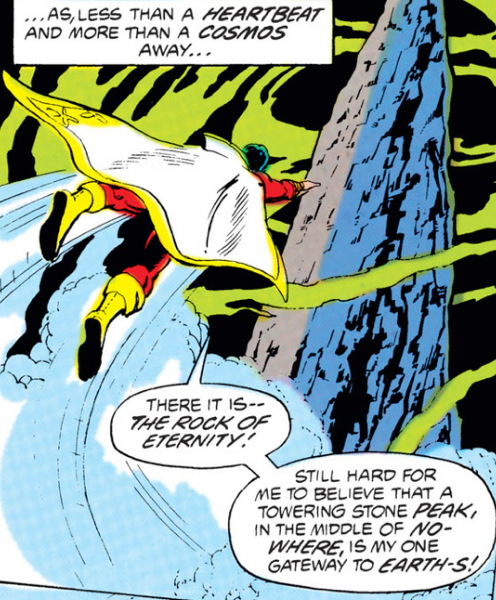
(That’s Superman in the panel, by the way…long story.)
I presume that changed to Earth-5, with the numerical designation, at around the time they were rejiggering the DC Multiverse a few years back, as per this entry in the Multiversity Guidbook from 2015:
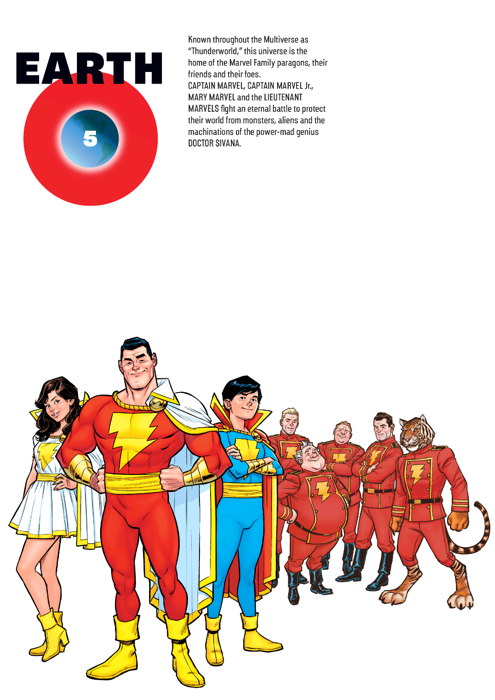
Please note it’s still the “Marvel Family” here, with all their proper names, as opposed to Main DC Earth’s continuity where they’re all named “Shazam” istead. YUCK, PHOOEY
By the way, the Multiversity-era version of the pre-Crisis Earth-X is called “Earth-10” but retains the “X” in its guidebook listing:
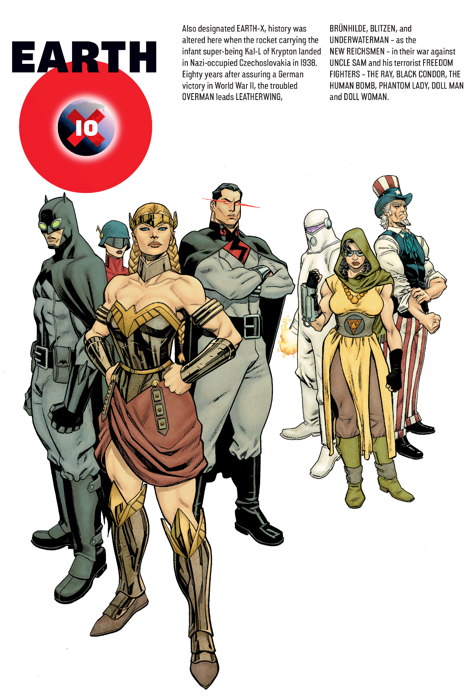
Back to Earth-5, or -S, or whatever…I’m not 100% sure of the first usage of the Earth-S designation. I thought for sure it would have been used in this story where Lex Luthor is mystically transported to the Marvel Family’s world in Shazam! #15 (1974):
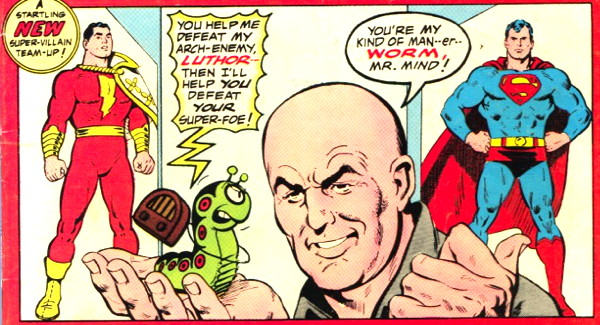
…but there’s not really any of the usual talk of “parallel Earths” or nuthin’ in the course of the story, and at the end Luthor wonders if it was all just a dream. I presume the editorial decision at the time was to keep Captain Marvel and his pals separate from the tonally-different DC Universe at large, save for a story like this where it could be kept at least somewhat ambiguous as to what actually happened, at least from the perspective of the characters.
Well, that escalated quickly, as I believe this brings us to Justice League of America #135 in 1976. That comic starts off a big multi-issue hoohar between Earth-1’s Justice League, Earth-2’s Justice Society, and the characters originally from Fawcett Comics, which of course brings in the Shazamers in later chapters:
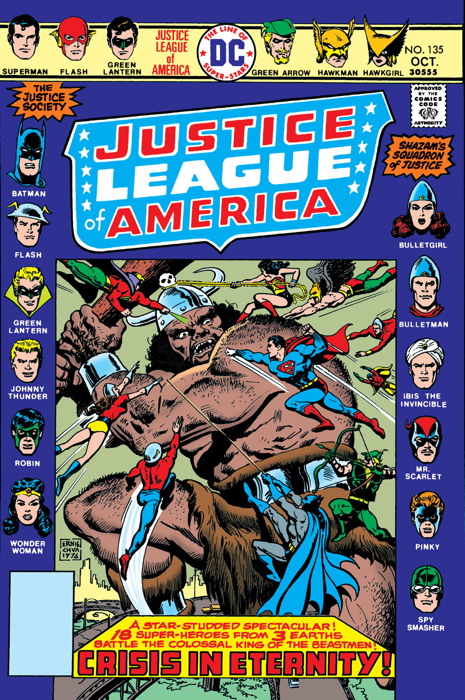
It’s inside this issue that we get what I believe is the first time the Marvel Family’s Earth is dubbed “Earth-S.” At least, its presentation here makes it look that way:
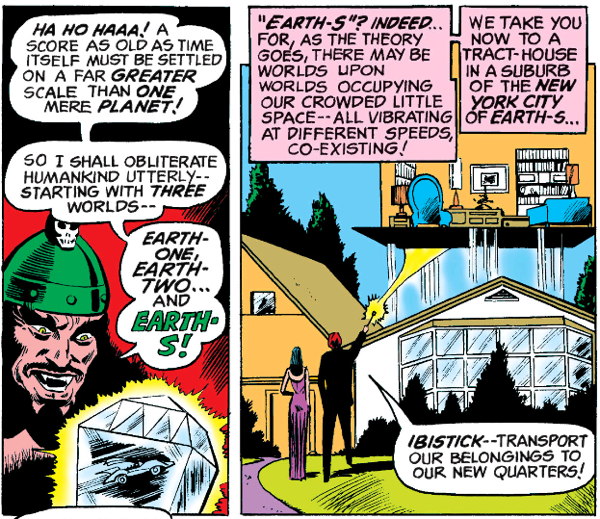
So ultimately, the answer to whether it was “Earth-5” or “Earth-S” is of course “yes.”
[um, SPOILERS AHEAD for Dark Knight Returns, I guess]
Joe Gualtieri has a question that should’ve occurred to me during my Old Joker discussion:
“I expect this kind of thing from these apps, but in the specific instance, how did they not think of Dark Knight Returns, never mind any of the stuff you named, Mike?”
Welllll…I forgot, and who knows about the people running the Hot Comics App…something like Dark Knight Returns is probably ancient history to them. But lemme defend myself just a tad here.
The Dark Knight Returns by Frank Miller, as most of us know, is about an older Bruce Wayne who returns to being Batman (hence the title) after having given up the costume a decade earlier. In issue #4 of Dark Knight (or “Chapter 4 of Dark Knight Returns” for you newfangled trade paperback readers) Bruce’s age is specifically stated as being 55:
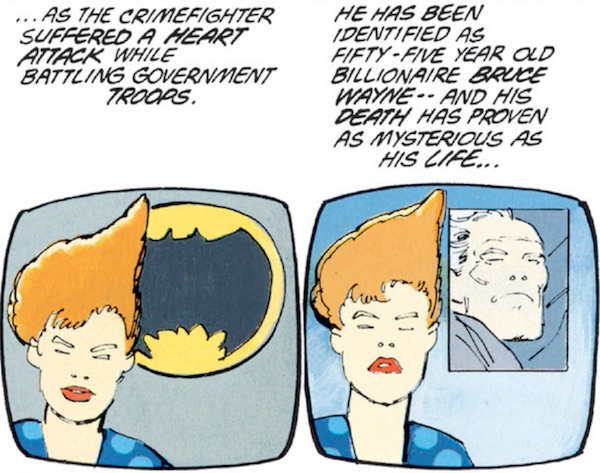
(Oddly, I found this article that goes through a lot of trouble figuring out Batman’s age in Dark Knight Returns and other related works by Miller…which ignores the explicit statement of 55 and comes to the conclusion that he was 48 in that series.)
Continuing the assumption from my previous post that Joker is likely of a similar age (the symmetry of Batman and Joker being “two sides of the same coin” and whatnot would, at least in my interpretation, possibly preclude too much of an age difference between the two), he would be about 55 as well. When we first see him in Dark Knight, he’s sitting quietly in the asylum watching TV when he sees the news of Batman’s titular returning:
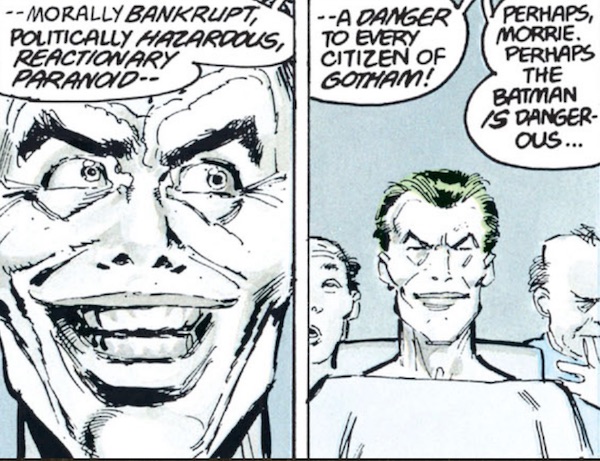
And then he cleans up pretty well for this TV appearance later in the story:
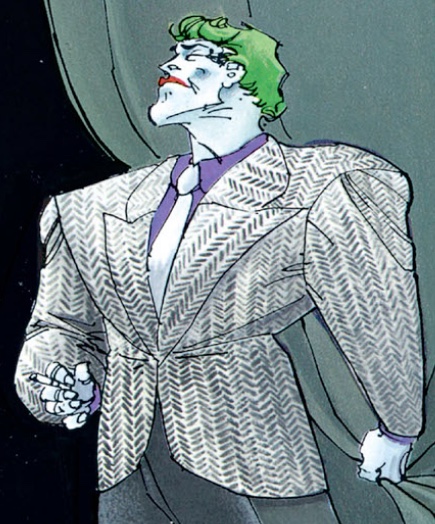
Now, to the Frank Miller who wasn’t yet 30 when writing and drawing Dark Knight Returns, 55 probably seemed terribly ancient to him. It would be inherently ridiculous for someone to still be running around dressed as a bat at that age. You know, instead of just running around dressed as a bat in his twenties, like a normal person.
But we can say neither Batman and the Joker are necessarily old-old in this series. I mean, the working premise of the story is that Bruce Wayne is too old to be doing Batman stuff, which isn’t necessarily the same as being elderly. Heck, even the 70-ish age we’d pinned Joker’s age at in some of his appearances listed in my previous post doesn’t seem as old as it used to. It all comes down to just what you think the world “old” entails. That Justice Society Annual entry in the Hot Comics App could simply be understood as “first appearance of a Joker that’s older that what we’re used to seeing.” They’d still be wrong, of course.
I think what I’m trying to say here, Joe, is that, as a person who as of this writing is 53 years old, I’m not going to think of 55-year-old Joker as old. Nope, no way, I REFUSE.
« Older Entries












 Now that’s entirely paraphrasing, but it was something along those lines.
Now that’s entirely paraphrasing, but it was something along those lines. 

























